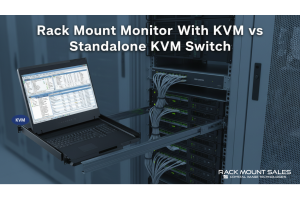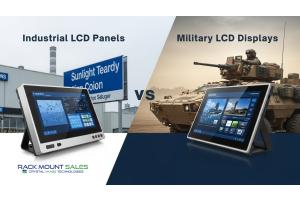Industrial LCD Monitors and Displays: Versatility and Reliability in Harsh Environments
In today's fast-paced industrial landscape, the demand for robust and reliable technology solutions has never been greater. Enter industrial LCD monitors and displays — the unsung heroes that have quietly revolutionized various sectors by conquering the challenges of harsh environments. From the bustling floors of manufacturing plants to the control rooms of transportation hubs, and the high-pressure operating theaters to the strategic command centers of the military, these specialized displays have become indispensable assets.
In this comprehensive guide, we embark on a journey to uncover the diverse applications and unparalleled advantages of industrial LCD monitors and displays. We will delve into their pivotal role in driving operational efficiency, enhancing decision-making, and ensuring seamless communication in industries where resilience and precision are paramount. With a focus on manufacturing, transportation, healthcare, logistics, and military applications, we will explore how these rugged displays have redefined the way information is accessed, presented, and harnessed in the face of extreme conditions. From the key features that set them apart to the numerous benefits they offer, we will shed light on why industrial LCD monitors have emerged as the preferred choice for industrial settings, propelling businesses towards a future of heightened productivity and reliability. So, fasten your seatbelts as we embark on this enlightening exploration of the unparalleled world of industrial LCD monitors and displays.
I. The Versatility of Industrial LCD Monitors and Displays
1. Manufacturing
- Process Control and Monitoring: Industrial LCD monitors enable seamless control of machines and processes, improving productivity and precision. They also display vital production statistics and quality control information, assisting in maintaining optimal manufacturing standards.
2. Transportation
- Information Display for Passengers and Drivers: Industrial LCD monitors in transportation systems provide real-time information to passengers, such as schedules, routes, and safety instructions. Additionally, they assist drivers with navigation and critical data for efficient operations.
- Traffic and Train System Monitoring: In control rooms, these displays are crucial for monitoring traffic and train systems, ensuring smooth operations and swift responses to emergencies.
3. Logistics
- Shipment Tracking and Inventory Management: Industrial LCD monitors are integral to logistics operations, helping track shipments, manage inventory, and optimize supply chain processes.
- Warehouse Automation: Monitors control robots and other automated systems in warehouses, streamlining operations and increasing efficiency.
4. Healthcare
- Patient Data Visualization: In healthcare settings, industrial LCD monitors display essential patient data, including vital signs, test results, and medical records, aiding healthcare professionals in making informed decisions.
- Surgical Imaging: Operating rooms utilize these high-quality displays to visualize surgical images and critical data during procedures, ensuring precision and accuracy.
5. Military
- Tactical Information Display: Industrial LCD monitors play a vital role in the military, presenting maps, data, and real-time information to soldiers and pilots, enhancing situational awareness and mission success.
- Weapons System Control: In military control rooms, these displays monitor and manage advanced weapons systems and military equipment.
II. Key Features of Industrial LCD Monitors and Displays
1. Rugged Construction
Industrial LCD monitors are built to withstand the harshest industrial conditions, thanks to their rugged construction and resilient materials. These displays are often crafted from robust materials such as metal and reinforced plastic, which provide excellent resistance to wear, tear, and external impacts. In industrial settings where equipment and machinery are constantly in motion, the durability of these displays ensures longevity and reliability, reducing the need for frequent replacements and maintenance.
Moreover, industrial LCD monitors are designed to endure severe vibrations and shocks. This feature is crucial in sectors like manufacturing and transportation, where heavy machinery, vehicles, and trains can generate substantial vibrations. By withstanding such harsh conditions, these displays maintain their functionality and visual performance, allowing for uninterrupted operations and reliable data presentation.
2. Wide Viewing Angles
In industrial environments, the positioning of LCD monitors may vary, with some displays mounted in elevated locations or installed in areas with restricted visibility. To address this challenge, industrial LCD monitors are engineered to offer wide viewing angles. This means that the screen's content remains clearly visible from multiple positions and angles, making it easier for operators and personnel to access crucial information without being constrained by the display's location.
Wide viewing angles are particularly advantageous in control rooms and manufacturing floors, where multiple operators need to monitor data simultaneously from different positions. This feature fosters collaboration and facilitates effective decision-making, leading to improved productivity and enhanced situational awareness across industrial processes.
3. High Brightness
Industrial environments often feature high levels of ambient light, whether it be intense artificial lighting or direct sunlight streaming into the workspace. To combat these challenging lighting conditions, industrial LCD monitors boast high brightness ratings. The high brightness ensures that the displayed content remains clearly visible and legible, even in the brightest environments.
This feature is especially critical in outdoor applications or control rooms with extensive windows that allow sunlight to enter. With the ability to deliver crisp and bright images, industrial LCD monitors provide operators and personnel with real-time information without compromising on readability. Whether in transportation hubs exposed to natural light or manufacturing facilities illuminated by powerful overhead lights, these displays ensure that essential data is readily accessible under any lighting circumstances.
4. IP Rating
The robustness of industrial LCD monitors extends beyond mechanical strength and visual performance; it also encompasses protection against environmental elements. These displays typically come with an IP (Ingress Protection) rating, which indicates their ability to resist dust and water ingress.
In dusty manufacturing environments or outdoor applications where industrial LCD monitors are exposed to the elements, the IP rating becomes crucial. The IP rating safeguards the internal components of the display from dust and debris, preventing malfunctions and preserving the display's performance. Moreover, the IP rating ensures resistance to water, making these displays suitable for use in areas where they might encounter water splashes or high humidity levels.
III. Advantages of Industrial LCD Monitors and Displays
1. Reliability and Longevity
- Enhanced Lifespan: Industrial displays are built to withstand extended use in harsh conditions, ensuring prolonged service life and reduced downtime.
- Low Failure Rates: With robust design and high-quality components, these monitors have lower failure rates, minimizing maintenance costs and operational disruptions.
2. Customization Options
- Tailored Solutions: Manufacturers often offer customization options, allowing businesses to select specific features and functionalities that align with their unique requirements.
3. Safety Compliance
- Regulatory Standards: Industrial LCD monitors adhere to stringent safety and quality standards, ensuring compliance with industry regulations and promoting a secure working environment.
- Electromagnetic Compatibility (EMC): These displays are designed to limit electromagnetic emissions and be immune to external electromagnetic interference, preventing disruptions in nearby equipment or sensitive systems.
- Security Protocols: In sectors like military and defense, industrial LCD monitors meet stringent standards to safeguard critical data and ensure the integrity of sensitive information.
- Reinforcing Safety Culture: By prioritizing safety compliance, industrial LCD monitors contribute to a secure work environment, allowing personnel to focus on tasks with confidence.
4. Cost-Effective Solutions
- Long-Term Savings: Despite higher initial costs compared to consumer-grade displays, industrial LCD monitors offer long-term savings due to their durability, extended lifespan, and low maintenance requirements.
Conclusion
Industrial LCD monitors and displays have proven their worth across diverse sectors, providing reliability, versatility, and ruggedness in the face of challenging industrial environments. From manufacturing and transportation to healthcare and military applications, these displays play a crucial role in enhancing operational efficiency, safety, and decision-making. With their rugged construction, wide viewing angles, high brightness, and IP ratings, industrial LCD monitors continue to be the preferred choice for businesses seeking dependable solutions for their industrial needs.











